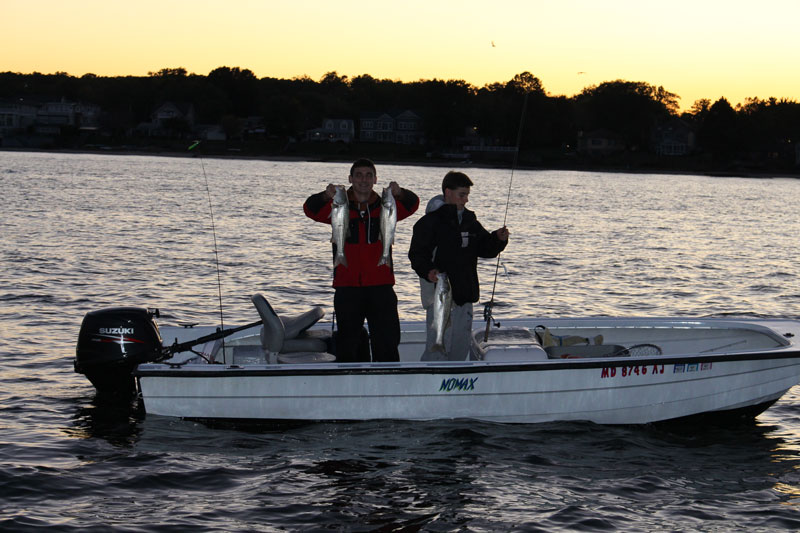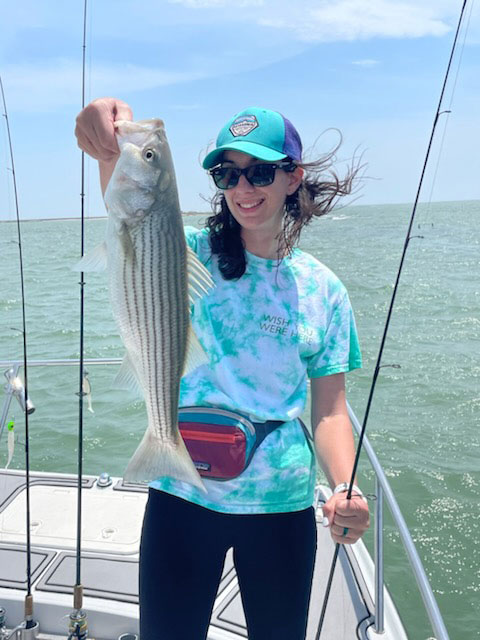One of the beautiful things about Chesapeake Bay fishing is that there’s no rule that can’t be broken, no prediction that can’t be right one day and wrong the next, and no one “correct” way to do things. There are, however, lots of usually-maybes. And the more of these usually-maybes you know, the more you can piece together the fishing puzzle on any given day. Part of figuring out what will work, where, and when, is understanding what triggers the fish to feed. And in the case of rockfish, there are some very specific triggers that will cause inactive fish to shift into feeding mode. The next time you’re not getting bites, see if you can put one of these trigger points into play.
Ambient Light

Dawn and dusk can be magic times for fishing, as 99.9-percent of you surely know. The changing light makes it easier for the predators to hunt, and fish normally go on a short but intense feeding frenzy during these timeframes. Heavy cloud cover can extend them, and on occasion, extend them through most or even all of the day.
Getting up in the predawn hours isn’t for everyone, nor is staying out on the Bay until nightfall. But if you go to any popular spot about an hour before dinnertime you’ll watch boat after boat pull up stakes and run for home shortly before the fish turn on. Conversely, at around 8 a.m. you’ll see boat after boat pull up and start fishing. In both cases, an hour or two of fishing later or arriving earlier likely would have doubled or tripled their catch. Again, most of us already have some level of awareness when it comes to fishing early and fishing late — yet many of us fail to alter our behavior.
An Easy Meal
When you’re walking through Sam’s Club and they have a sweet-smelling free sample for you to taste-test, do you reach for the toothpick? Not everyone does but many people sure do, regardless of how hungry they may or may not actually be. Similarly, even when they aren’t actively munching an easy meal can be hard for a rockfish to turn down. An injured baitfish struggling to swim is the perfect example. Why work for your meal later, when there’s a rare freebie being offered up right now? Hence, the effectiveness of live-lining with spot. There will be times (more than I personally care to remember) when you can drag a jig through the strike zone 100 times without getting a bite, but a live spot lobbed into the very same location gets slammed in moments.
Current on Structure

Areas where current smacks into solid structure, be it a bridge piling, rip-rap, or a point, should always be prime targets. But at many spots, particularly in the shallows, the current will be hitting the structure only when the tide is going in one direction or the other. Time on the water is the only way to build up a memory bank as to which spots get the “right” current and when. So as you fish, you should constantly keep track of the slice of the tide you’re fishing in and try to match that data up with your results at the different hotspots you hit. Over time, you’ll realize that point X is good on an incoming tide but deader than a doornail on an outgoing, and spot Y produces on the outgoing but isn’t a great place to try on an incoming.
Feeding Frenzies
Rockfish in feeding frenzies are sort of like people at a rowdy party — when all heck breaks loose, everyone tends to get caught up in the excitement. Lucking into a feeding frenzy is one of those times when fishing can become downright easy, and you could hook up by tossing a chunk of hot dog on a Barbie rod. But luck isn’t the sole factor at play. You can up your chances of finding a frenzy by investing in a good pair of binoculars (image stabilized models with a magnification factor of at least 12 or more are best), which will more than double the distance at which you can spot diving birds. In some cases, you can even trigger a feeding frenzy of your own. Toss 30 or 40 spot over the side when there’s a school of inactive rockfish below, and you most certainly do have a good shot at triggering a bite. Carry a bucket full of bull minnow, use them in large numbers to seed the waters, and nearby fish will often react in a big way. Tip (not for the faint of heart): bounce minnow off the side of your boat, by the handful. The ones that get stunned will pinwheel in circles, and immediately become one of those easy meals we talked about a moment ago.
Tidal Shifts
No fish feeds like clockwork, but as a general rule of thumb striped bass do tend to feed most actively during the last hour of the tide and into the change of the tide, often pausing during the slack but picking up again early in the next tidal cycle. This pattern is most pronounced early in the season and least pronounced late in the fall, but the trend does hold true (absent any other feeding triggers) most of the time.
We certainly can’t control the tides and currents, but we can react to them. In the Chesapeake, you can run north or south to catch up to, or effectively accelerate, the changes. When an outgoing current slacks, running north will move the clock forward. Running south turns it backwards. And running east-west can also help shuffle the tidal deck. And if you have enough flexibility in your fishing schedule, you can pour over the tide charts prior to a trip and plan out where you want to be and when, to maximize the bite potential.
Okay: now that we’ve got these feeding triggers in mind, we have one more piece to put into the puzzle. Now, let’s think about water clarity and temperature, seasonality, matching the hatch, lure choice and presentation, wind direction, rod/reel/line choice, and about 1000 other variables… puzzles like this are simple, right?